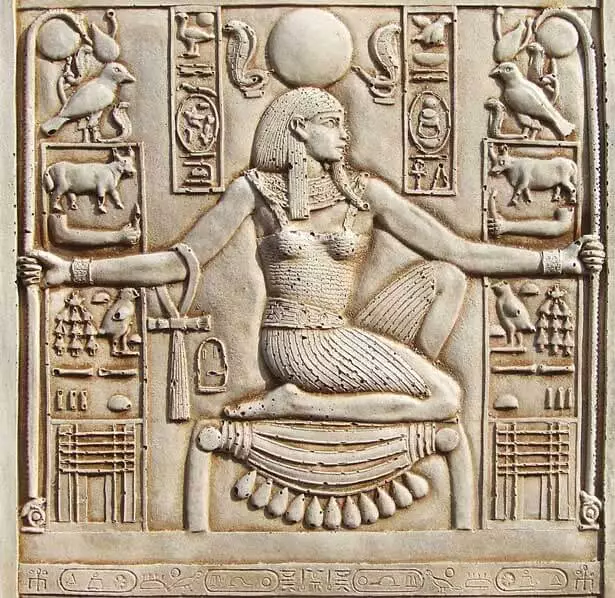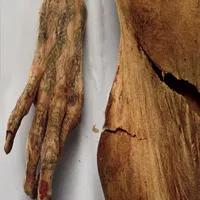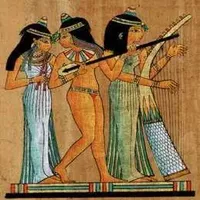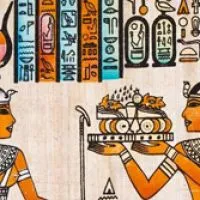Unraveling the Style Secrets: An In-Depth Look at Ancient Egypt Clothes
The story of Ancient Egyptian clothes is as rich and complex as the civilization itself. The ancient Egyptians were known for their attention to beauty and cleanliness, which extended to their clothing. They wore clothes made of light and airy linen, perfect for their hot, dry climate. The color of the clothes was typically white, which reflected the heat and kept the wearer calm.
However, clothing was not just a necessity for the ancient Egyptians. It was also a symbol of status and personal identity. The clothing a person wore indicated their social standing, occupation, and even their religious beliefs—the more elaborate the clothing, the higher the person's status.
In addition to the basic garments, the ancient Egyptians also wore various accessories and jewelry. These items were often colorful and intricately designed, adding another layer of beauty and complexity to their attire. From the headdresses worn by pharaohs to the simple linen tunics worn by commoners, clothing was an integral part of ancient Egyptian culture.
In ancient Egypt, linen cloth was the most well-known material. It was very agreeable in the subtropical warmth. The fabric was produced by spinning the flax plant strands from the plant's stem. Turning, weaving, and sewing were vital for Egyptian social orders. Plant colors could be used to dye garments. However, the attire was generally left in its regular shade. Fleece was rare, however, because ancient Egyptians viewed it as unclean. Just the rich wore creature strands that were the object of taboos. They were utilized repeatedly for jackets and leather or lamb wool clothing. However, animal skins were taboo in sanctuaries and havens.
Men's Clothing in Ancient Egypt
Men's clothing in ancient Egypt was relatively simple. The most common garment was the shandy, a skirt-like garment wrapped around the waist and tied at the front. The length of the shendyt varied depending on the wearer's status and the current fashion trends. Noblemen and pharaohs often wore longer sheets, while laborers and enslaved people wore shorter ones.
In addition to the shandy, men also wore various other garments. These included tunics, cloaks, and even trousers. These garments were usually made of linen and were often adorned with patterns or embroidery.
Men also wore a variety of accessories. These included belts, necklaces, bracelets, and rings. These items were often made of gold or silver and were sometimes decorated with gemstones. From around 2130 B.C. in the Old Kingdom, Egyptian dresses were straightforward. The men wore wraparound skirts known as the Shendyt, which were belted at the waist, now and again creased or accumulated in the front. At this time, men's skirts were short. As the Middle Kingdom of Egypt arrived around 1600 B.C., the dress began to be worn longer. Around 1420 B.C., a light tunic or pullover with sleeves and a creased slip appeared.
Women's Clothing in Ancient Egypt
Women's clothing in ancient Egypt was slightly more complex than men's. The most common garment was the kalasiris, a simple, fitted linen dress that could be worn in various ways, depending on the wearer's preference and social status.
In addition to the kalasiris, women also wore various other garments. These included shawls, capes, and even trousers. Like men's clothing, these garments were usually made of linen and were often adorned with patterns or embroidery.
Women also wore a variety of accessories. These included belts, necklaces, bracelets, and earrings. These items were often made of gold or silver and were sometimes decorated with gemstones.
Ancient Egyptian ladies frequently wore straightforward sheath dresses called kalasiris in the Old, Middle, and New Kingdoms. Ladies' attire in ancient Egypt was more moderate than men's garments. The skirts were held up by maybe a couple of straps and extended to the lower leg, while the upper edge could be worn above or beneath the bosoms. The length of the dress indicated the social class of the wearer. Beading or plumes were additionally utilized as frivolity on the dress. Over the dress, ladies decided to wear shawls, capes, or robes. The mantle was a bit of material around 4 feet wide by 13 or 14 feet long. This was, for the most part, worn and creased. Female garments changed somewhat as the millennia progressed. Hanging dresses (with numerous assortments of drapery) sometimes gave the impression of totally diverse attire. It was made of hawk, which was a fine muslin cloth.
Children's Dresses in Ancient Egypt

Kids wore no garments until they were six years old. When they turned six, they were permitted to wear apparel to shield them from the dry warmth. A prevalent haircut among the youngsters was the slide-lock on the right half of the head. Even though youngsters, as a rule, youngsters wore no apparel, they wore adornments, for example, anklets, wristbands, collars, and hair extras. When they grew up, they wore the same styles as their guardians.
Importance of Clothing in Ancient Egypt
Clothing played a significant role in the ancient Egyptian society. It was not just about protection from the elements or modesty but also a reflection of a person's status and wealth. The more elaborate and expensive the clothing, the higher the wearer's rank in society.
The ancient Egyptians also believed that clothes had a spiritual significance. They thought their clothes could affect their journey to the afterlife. The deceased were often buried with their most beautiful clothes and jewelry, believing this would help them in their journey to the afterlife.
Moreover, clothing was essential to religious rituals and ceremonies in ancient Egypt. Priests and priestesses wore special garments during these events, which were believed to give them a closer connection to the gods. These garments were often made of the finest linen and adorned with precious gems and metals.
Materials Used in Ancient Egyptian Clothes
The primary material used in ancient Egyptian clothes was linen from the flax plant. Flax was abundant in Egypt and easy to process into a fabric. Linen was ideal for the hot and dry Egyptian climate, as it was light, breathable, and could be woven into various thicknesses.
While linen was the most common fabric, the ancient Egyptians also used other materials for their clothes. For example, they used wool for their winter clothes, which was less common than linen. They also used leather for shoes and belts, and feathers for decorative purposes.
The ancient Egyptians also used dyes to color their clothes. These dyes were made from plants, minerals, and sometimes even insects. The most common colors were blue, red, and yellow, but they used green, purple, and black.
Styles and Fashion Trends in Ancient Egypt
Fashion in ancient Egypt evolved, but certain styles and trends remained popular throughout the civilization's history. One of these was the use of pleated linen. The ancient Egyptians were skilled at pleating and could create intricate designs with their clothes.
Another trend was the use of sheer linen. This was especially popular among the upper classes, who could afford the finer, more transparent linen. This fabric allowed the wearer to show off their body without being indecent, a sign of wealth and status.
The ancient Egyptians also loved patterns. They often decorated their clothes with geometric designs, floral motifs, and even hieroglyphs. These patterns were usually woven into the fabric or embroidered onto it.
Hierarchical Significance of Ancient Egypt Clothes
Ancient Egyptian clothes also served as indicators of a person's social status. The pharaohs and the nobility wore the most elaborate and expensive clothes. They wore garments made of the finest linen, adorned with gold and precious gems. Their clothes were often dyed in vibrant colors, a luxury the ordinary people could not afford.
The priests and priestesses also wore special garments. These were usually white, symbolizing purity, and were often adorned with religious symbols. The ordinary people, on the other hand, wore simpler clothes. They usually wore a simple tunic or dress made of coarse linen without any adornments.
Enslaved people and laborers wore the simplest clothes of all. They often wore nothing more than a loincloth or a simple skirt. Despite these differences, all ancient Egyptians wore practical and suitable clothes for the climate regardless of their social status.
Accessories and Jewelry in Ancient Egypt

Accessories and jewelry were an essential part of Ancient Egyptian clothes. They were not only used to enhance the beauty of the clothes but also to convey the wearer's status and wealth—the more elaborate and expensive the accessories, the higher the wearer's social rank.
The ancient Egyptians wore a variety of accessories. These included belts, necklaces, bracelets, earrings, and rings. These items were often made of gold or silver and were sometimes adorned with gemstones. They also wore headbands, headdresses, and wigs, often decorated with flowers, feathers, or jewels.
In addition to these accessories, the ancient Egyptians also used cosmetics and perfumes. These were considered essential to personal hygiene and beauty and were often used in religious rituals.
The Evolution of Ancient Egypt Clothes Over Time
The style and fashion of Ancient Egyptian clothes evolved. In the Old Kingdom, the clothes were relatively simple and practical. However, as civilization progressed, the clothes became more elaborate and decorative.
During the Middle Kingdom, pleats and sheer linen became more common. Clothes were also decorated with more intricate patterns and designs. The New Kingdom saw the height of ancient Egyptian fashion with the introduction of more complex garments and accessories.
Despite these changes, the essential elements of ancient Egyptian clothing remained the same. They continued to use linen as the main fabric, and the clothes were still designed to be light and airy, suitable for the hot, dry climate.
The Influence of Ancient Egypt Clothes on Modern Fashion
The influence of Ancient Egyptian clothes on modern fashion is undeniable. Many popular styles and trends in ancient Egypt can still be seen in today's fashion. For example, pleats and sheer fabrics are still standard in modern fashion. The ancient Egyptians' love for patterns and bright colors can also be seen in many contemporary designs.
In addition to these stylistic influences, the ancient Egyptians also left a lasting impact on the fashion industry through their innovations in textile production. They were one of the first civilizations to use linen as a fabric, and their techniques for weaving and dyeing are still used today.
Moreover, the ancient Egyptians' emphasis on beauty and cleanliness influenced modern beauty standards. Using cosmetics, perfumes, and personal hygiene products is a standard part of many daily routines.
Egyptian Ancient Footwear
Footwear was the same for both sexual orientations. It was comprised of leather shoes or papyrus for the consecrated class. Egyptians were typically unshod, and shoes were worn only at uncommon events or when their feet might get hurt.
Conclusion
In conclusion, Ancient Egyptian clothes were practical garments and expressions of personal identity, social status, and spiritual beliefs. They were made with skill and creativity, using beautiful materials and intricate designs. Despite the passage of thousands of years, the influence of ancient Egyptian fashion can still be seen today. Whether it's the use of linen, the love for patterns and colors, or the emphasis on beauty and cleanliness, the legacy of ancient Egyptian clothing continues to inspire and fascinate us.




































